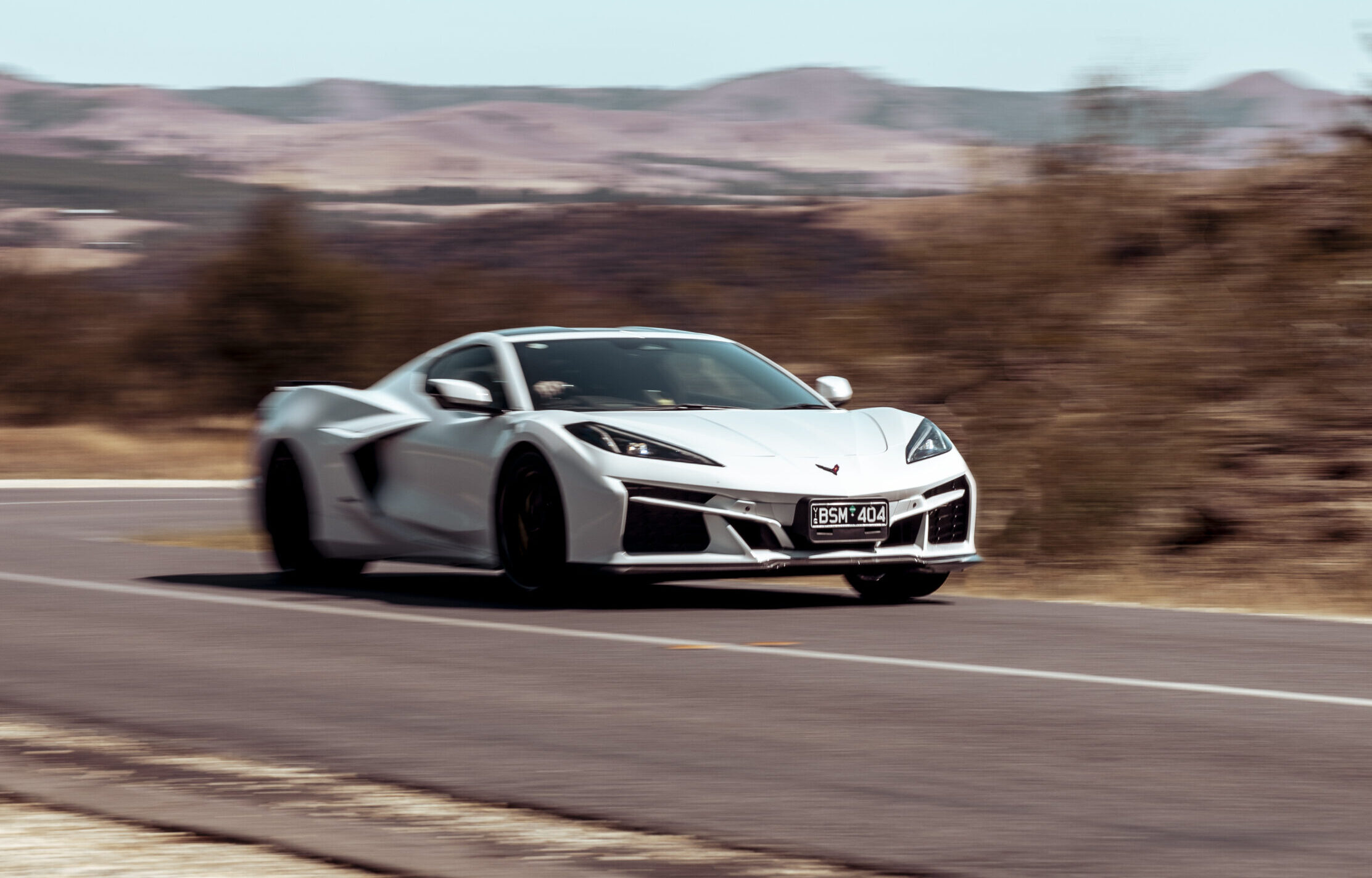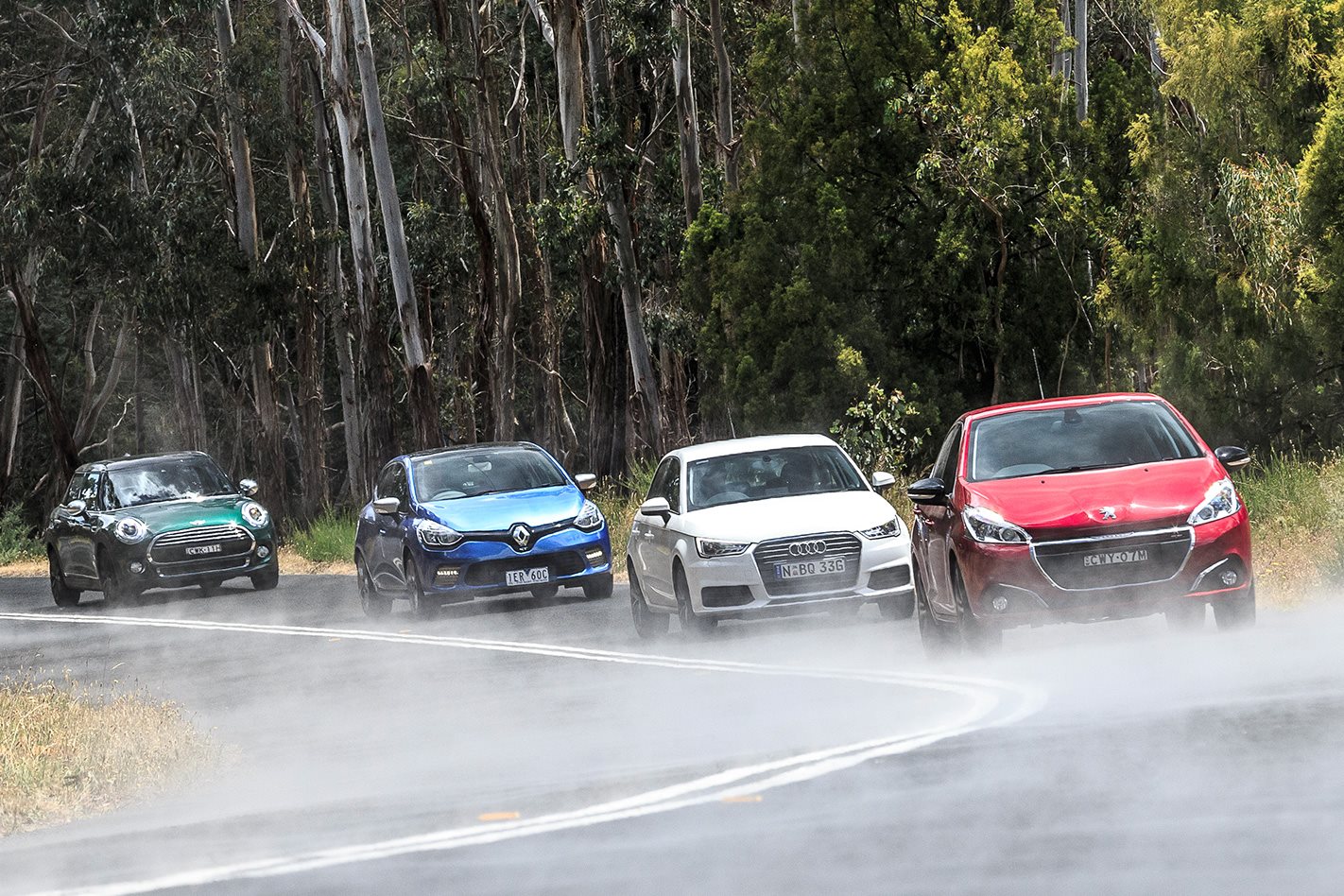
Remember the time before the modern Mini burst onto the scene 15 years ago, when the notion of a premium baby hatch seemed as absurd as a $30K Toyota Yaris would today? In pre-Millennium Australia, petite always meant cheap.
But BMW’s resurrected British brand has subsequently converted urbanites and confounded Doubting Thomases, building an almost evangelical following globally. Like people willing to pay $50 for a Gold Class movie ticket, it’s all about the experience.
Some have tried to emulate the Mini’s winning formula with hits (Fiat 500), what-evs (Citroen DS3) and misses (Alfa Mito), but only arch-enemy Audi’s VW Polo-based A1 has truly menaced the Mini. Together, they control some 80 percent of the booming $25K-plus Light class in Australia, which – driven by lots of fresh metal – was up 20 percent last year.

Happily, all that rivalry has forced Munich to firstly slash prices (today’s third-gen Mini, released in 2014, starts from $24,950 compared to $32,650 for a base Cooper in 2001 – which is $46,500 in today’s money). And, secondly, to present the first Mini-based five-door since BMC’s Morris Nomad of 1969 to take on that pesky Audi A1. Naturally enough, Ingolstadt responded last winter with a minor makeover headlined by broadly similar ‘repositioning’.
However, it was a pair of promising French upstarts that prompted this shootout. In our nine-car supermini Megatest (Wheels, March 2015), Peugeot’s under-rated 208 managed a respectable fourth thanks to excellent packaging, a classy cabin, sassy styling, sparkling dynamics and a comfy ride – which had us thinking that the upcoming Series II version (subsequently released last October) might be improved enough to joust with the Germans.
As the newest model here, the GT-Line (from $27,490) is the sportiest non-GTi hot-hatch expression of the revamped Peugeot 208 range, which sports a near invisible facelift (basically the front bumper has changed), substantially lower entry pricing (now from $15,990) and a new 81kW/205Nm 1.2-litre turbo triple, mated solely to a Toyota-supplied six-speed torque-converter auto, in place of the previous 88kW/160Nm 1.6-litre atmo four and old-school four-speed.
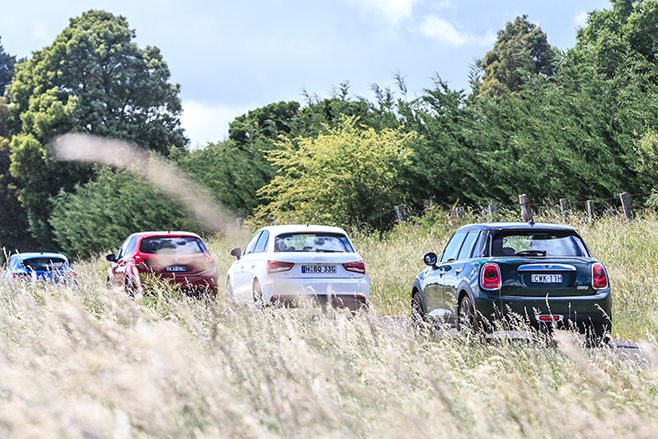
Though boasting sat-nav, self-parking, touchscreen connectivity, climate control, and auto lights and wipers, you pay extra for niceties such as metallic paint (pricey at $990) and reversing camera ($300 – or $500 with Autonomous Emergency Braking). That said, the GT-Line looks appealingly GTi-like, brandishing cool 17-inch alloys, front cornering lamps, LED daytime-running lights, bolstered sports seats and racy pinstripe/gloss trim inserts.
Our second contender from France (via Turkey), the Renault Clio GT costs $28,990 in as-tested Premium guise (just $500 short of a base Renaultsport 200) and comes with a fixed glass roof, heated front seats, camera, spoilers and an endlessly entertaining ‘R-Sound Effect’ app that mimics a bunch of Renaults, Alpines and even a Nissan GT-R.
On the other hand, you’ll save $3500 by going with the non-Premium GT and still score the semi-fat Renaultsport-tuned chassis (slightly firmer springs and dampers), RS Drive Sport mode (larger throttle openings, faster gearchanges, heavier steering, a tuned diff), paddle shifters, unique bumpers, huggy seats, rear sensors, keyless entry/start, sat-nav, climate control, LED DRLs, 17-inch alloys and the group’s only five-year warranty. But no AEB. Nor, controversially, rear-seat curtain airbags, though Renault reckons beefing up the surrounding panels makes them redundant…
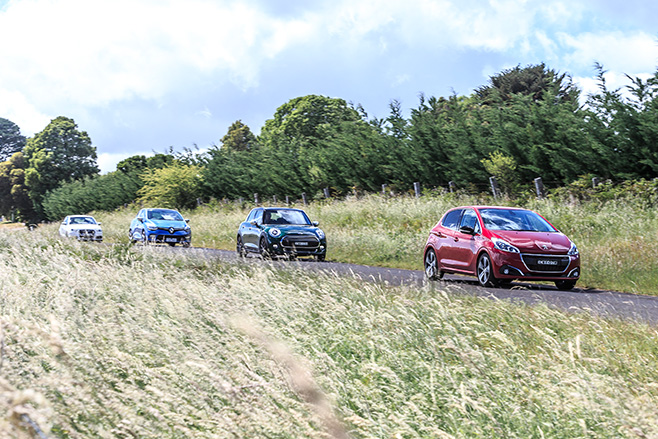
Whatever, the Clio’s here because of stellar recent form: a $20K Expression with the same 88kW/190Nm 1.2 turbo and six-speed dual-clutch (the only gearbox available in four-cylinder models) managed a bronze in that supermini Megatest, while a 0.9-litre three-pot turbo manual topped Fiesta Sport and Alfa Mito TwinAir (Wheels July 2014). The Clio IV range was also a podium finisher in 2013’s COTY. Will its luck hold?
France versus Germany, then. Not for the first time.
Representing the Fatherland, though built in England (is this what the automotive world would be like if the war went the other way?), the F55-series Cooper five-door from $27,750, or $30,100 with a six-speed torque-converter auto, riding on a 72mm-longer wheelbase for extra rear-seat space over the three-door Mini Cooper. For $1700 more than the entry-level five-door, the Cooper gets a friskier 100kW/220Nm 1.5-litre triple (instead of a 75kW/180Nm 1.2) and gains a leather wheel, cruise control with brake function, rear sensors, auto lights and wipers, and 15-inch alloys.
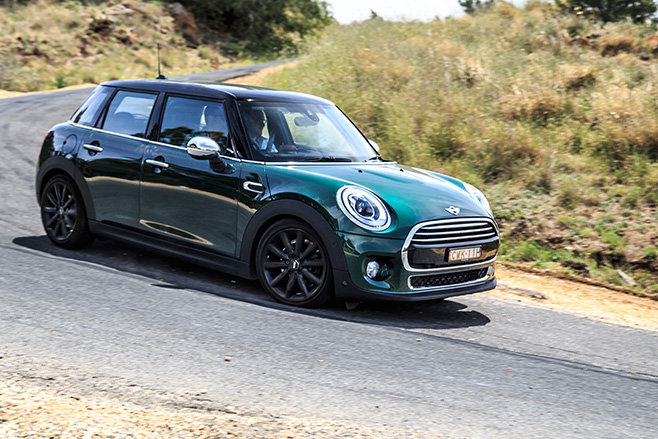
However, our test car arrived with options totalling $15K, including Pepper Pack (essentially climate control, fog lights, front armrest and uprated audio for $3K), fancy ‘cross punch’ leather ($2500), 17-inch alloys and a double sunroof ($2K apiece), AEB ($1350), a head-up display ($850), front radar ($700), metallic paint ($800) and Harman Kardon sound ($1200). Little wonder ours felt like a baby British Bimmer inside.
Audi’s A1 Sportback Series II comes from Belgium, wearing a wider grille, bigger bumpers, revised headlights and wavy tail-light lenses. More importantly, an oh-so-sweet 70kW/160Nm 1.0-litre three-cylinder turbo debuts at entry level, priced from $26,900 with a five-speed manual or $28,250 with an S-tronic seven-speed dual-clutch.
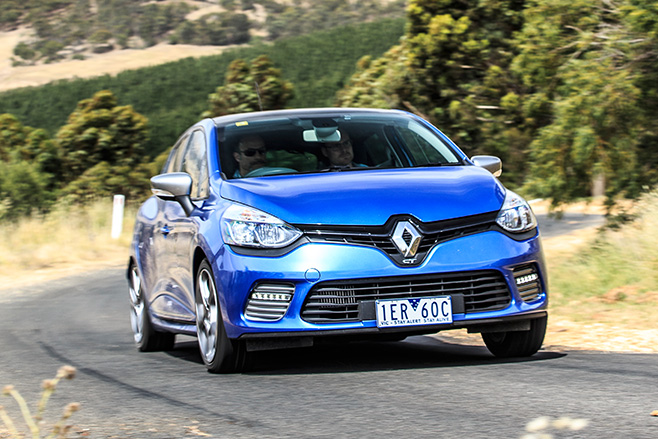
Equipment levels aren’t lavish – cruise, auto lights and wipers, paddle shifters, manual air-con, rear radar, Bluetooth and 15-inch alloys – though ours runs out to $32,730 with the $2K Style (xenon headlights, LED DRLs, 17-inch wheels) and $2500 Technik packs (sat-nav and better audio). Underlining the fact the A1 is this group’s veteran, it has no auto-brake safety tech.
Turning to the road, we start with the Pug, the freshest of the Frenchies. Despite the extra performance, extra gears and 55kg lighter nose that downsizing delivers, the Pug’s Pure Tech heart transplant isn’t the anticipated silver bullet here, though real-world acceleration and responses – particularly in an urban environment – are now much livelier. Yet there isn’t the sizzle of the 80kg-heavier 308 equivalent with its stronger 96kW/230Nm punch. So the GT-Line feels a bit flat, like something is holding it back. For instance, there’s a momentary hesitation when moving away from standstill, like old-school turbo lag. It’s only beyond that where the Pure Tech pulls away energetically, aided by a quick-witted shifter. We were expecting more fizz, frankly.
That the 208 is generally the most economical – all contestants here are equipped with fast-acting idle-stop systems for effective emissions relief – reflects the Peugeot’s drivetrain efficiency.
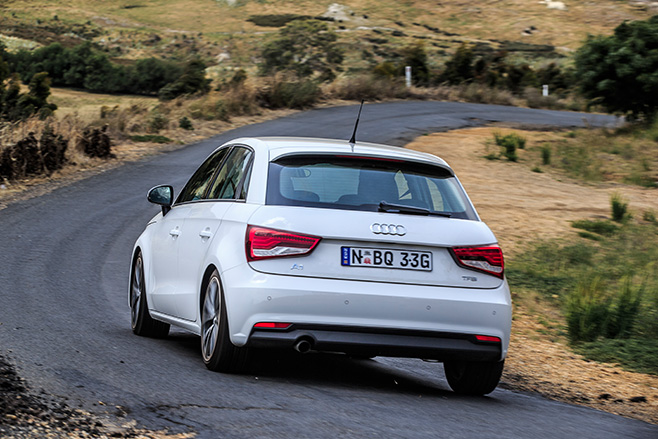
Around town, the dual-clutch Clio’s long-moaned-about lag remains a point of frustration. Forget about point-and-shoot take-offs; it seems to take an eternity for turbo and transmission to spool up before there’s any consensus for momentum, with a bit of initial drivetrain grumble thrown in.
Once moving, however, Renault’s 1.2 turbo four provides robust yet refined performance, particularly in the 80-120km/h bracket where it leaves the smaller-capacity triples trailing. Also, even forgoing the gimmicky RS sound effects, there’s a satisfying sensation of speed – certainly more so than the mere 0.1sec gap to 100km/h between it and the 208 suggests.

At face value, the Clio’s fuel consumption might appear alarming, but that’s because we chose to engage the RS Drive’s addictive Sport mode, taking full advantage of the wider throttle openings and faster gearshifts. Egged on by a sexy baritone exhaust, it was simply driven harder for longer than the others. Just to be fair, though, one tankful in snooze mode returned the best result of the test – 6.5L/100km. But could you restrain yourself?
Audi’s terrific 1.0 TFSI was the slowest in all categories against the clock, but in everyday driving its energetic power delivery, combined with seven cleverly spaced ratios, makes for a spry point-to-point runabout, squirting well above its meagre engine capacity. This thing begs to be thrashed, and rewards doing so. Indeed, the A1 feels as fiery as the fastest here (the Cooper). Only when loaded, or climbing hills, does the lack of cubic inches hurt. That it returned near-best economy numbers while being driven flat-out highlights the brilliant engineering behind this perky little powertrain.
No rival can match the sheer power and flexibility of the 100kW Cooper, however. Thrummy yet cultured, it is the only car here with no discernible lag off the line, the best for prompt throttle responses, the least affected by cargo or inclines, and fast enough to eclipse 160km/h before we ran out of track during performance testing. Lower-spec Mini engines have long lacked balls, but this charmer belts along while remaining impressively frugal. The 1.5 Cooper’s $1700 premium over the 1.2 One is money well spent.
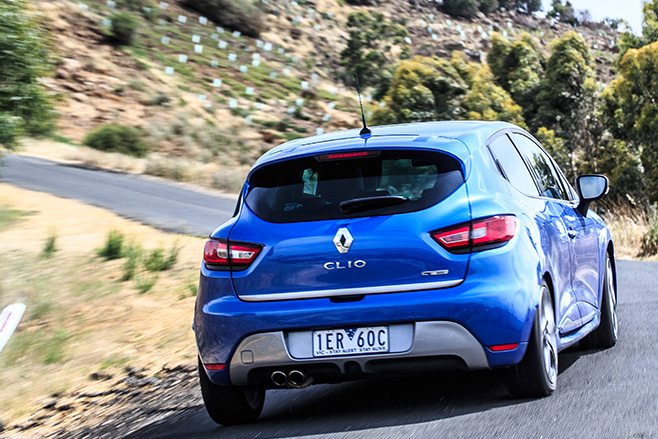
It’s therefore mildly frustrating that BMW’s engineers have dialled back much of the Mini’s one-time steering sharpness. Some of the low-speed bite has given way to a consistent, measured and predictable helm that you might expect in a Golf, making a mockery of the brand’s ‘go-kart’ claims. Yes, the handling is flat, planted and controlled, and the five-door’s dynamics gel nicely at higher velocities, but where’s the intimate feedback gone? Mr J Cooper would be puzzled. At 57, Mini appears to be having a mid-life crisis.
Exacerbating our grievance is the suspension’s inability to properly soak up bumps with the optional 17-inch wheels. Only on the slickest surfaces is the ride quality acceptable. Words like “unsettled”, “bumpy” and even “terse” abound, undermining the Cooper’s newfound maturity elsewhere. Best you shell out $700 for adaptive dampers, which make a big difference.
Almost the opposite is true for the 208. At low speeds, its steering is really reactive – maybe too much for the uninitiated – with crisp turn-in backed up by heaps of feedback. It’s how Mini ought to be. But where the British-branded runabout seems magnetised to the road when belted through tight corners, the Pug’s back end lightens up playfully for controllable rear-steer fun, underwritten by a relaxingly supple (if at times noisy) ride. Nice one, Peugeot.
However, when you’re really on it, there’s too much suspension travel and body movement, and not enough control, to match the GT-Line’s athletic visage. Driven like a 208 GTi (which only costs another couple of grand), you’re likely to feel queasy after a while.
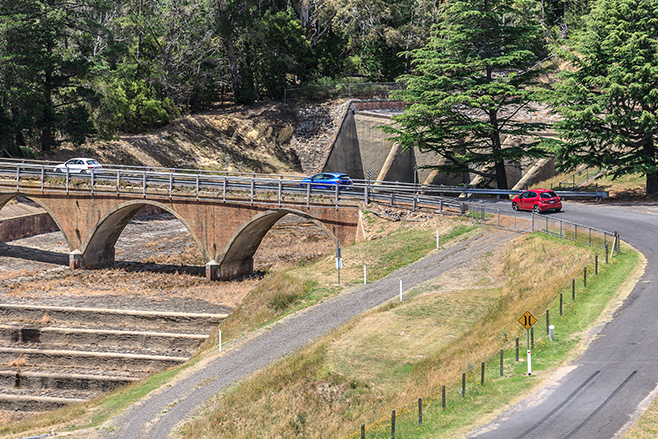
In contrast, the A1 rarely puts a foot wrong, combining quick and communicative steering, capable and predictable handling, reliable roadholding and pleasing chassis absorbency. In many ways it’s just like a scaled-down Golf. And when you step on it more, it all coalesces into a safe, controllable and ultimately vice-free dynamic performer. However, there isn’t the same level of interaction or liveliness as in the rest, while rougher roads reveal some suspension clunkiness, along with insufficient wheel travel. As with most VW Group products, you come away with colossal admiration rather than any emotional connection.
The converse applies to the Renault. In most situations it is the most exciting, involving, composed, controlled and connected hatch here. In RS Drive Sport mode, car and driver mesh, resulting in real steering capability, though it’s a little heavy at parking speeds. But there’s a naturally calm and measured rhythm to the handling that is unique in this company. No rival puts a smile on your face stringing together a set of corners like the Clio can.
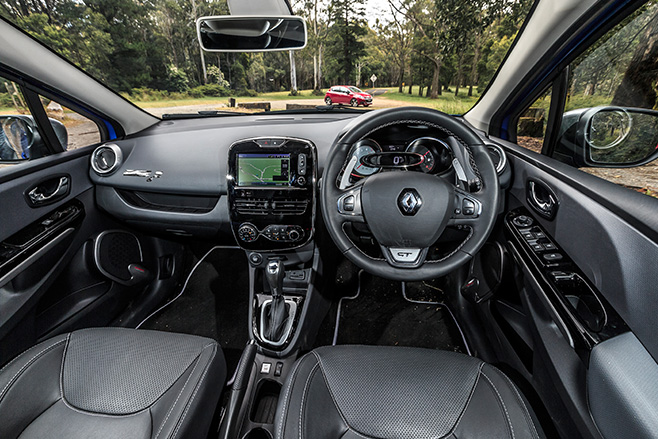
That the Clio’s ride is also the best overall reflects Renaultsport’s remarkable tuning prowess. Even if it isn’t as cushy as the comparatively spongy 208’s, nothing is as pliant over bumps and potholes as the Clio GT, despite it being essentially a warm hatch.
Fascinatingly, while alone in this group in persisting with rear drums, the Clio finished mid-field for braking.
Similarly disparate levels of character differentiation also exist inside each of the assembled quartet, though all can accommodate five occupants, with the ability to carry two adults in the back seat in reasonable room and comfort.
Shockingly, least impressive inside is the A1 Sportback, despite its elegant, solid and quality dashboard, which still looks contemporary six years on, supported by an excellent driving position and fine ergonomics. But the Audi is a car of two halves; the tight rear quarters’ spartan and monochrome presentation is only just acceptable in a Polo Trendline costing half as much, and the lack of map pockets reflects unfortunate penny-pinching.
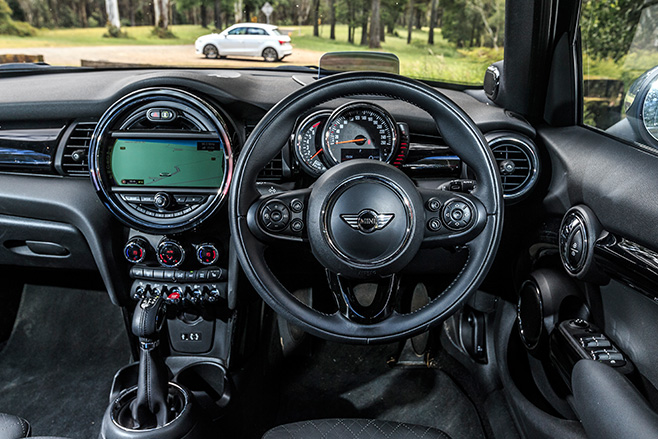
The Clio is also not great in the back. The sports front seats block forward vision, the backrest’s headrests are all but useless, and the rear cushion errs on the firm side. The lack of a rear-seat courtesy light is also a mean omission. Up front, the centre console’s shape tends to foul passenger knees, and the glovebox is frustratingly small, but otherwise the Renault scores for superb instruments, alluringly comfy front seats and sound placement of most switches and controls.
Keeping in mind that our test Cooper heaved with extra gear, the overall interior presentation is defined by a solid, quality look and feel, even if the car’s signature styling cues – rounded centre screen, toggle switches and circular themes – are wearing thin.
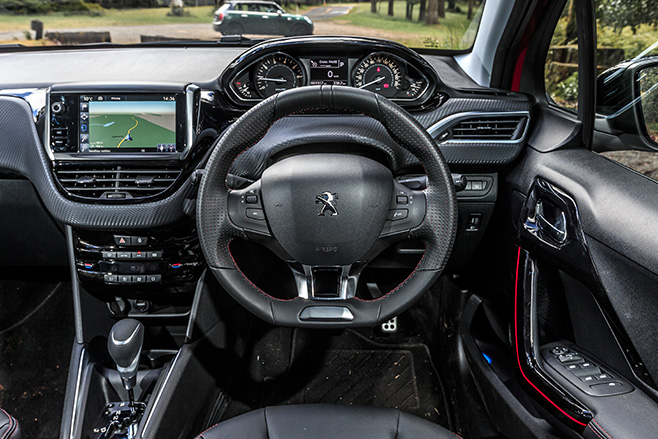
Speaking of thin, the Mini’s stunted rear doors look a little odd (in a 1950s Austin A30 sort of way) and restrict entry/egress. Also, thick pillars and a high shoulder line impact vision, the optional sunroof reduces head room (with a mesh ‘blockout’ that doesn’t), the glovebox is meagre, and an infernal rattle undermined the otherwise premium aura. Yet the optional sports front seats shine, the driving position is first class, there are rear-seat cupholders and grab handles, and the ergonomics are good.
All the same, the 208 takes the cake for packaging and comfort, scoring for space, practicality, useability and, above all, interior style. Despite lacking a rear-seat area light, grab handles and adequate glovebox, the Pug’s ambience matches the exterior’s aggressiveness. Further bonuses include body-hugging front seats, a classy fascia featuring the brand’s controversial (but effective) low-wheel/high-binnacle positioning, elegant instrument markings, ventilation aplenty and appreciably deep windows. But we were irked by loose-trim noises and fat A-pillars that obscure traffic.
Every car here has pros and cons, but they’re all really capable and likeable urban runabouts, so each deserves a podium finish. There isn’t a dog among them, and we’d happily recommend all four seeing just half a star separates last from first.
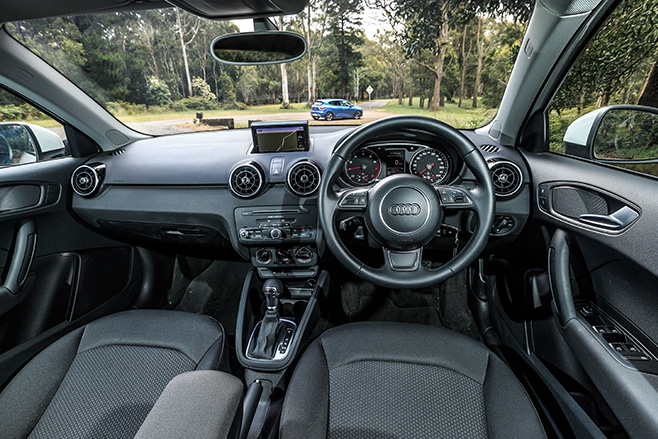
That said, the A1 Sportback 1.0 TFSI is showing its age, despite possessing a soaring new drivetrain. While hardly putting a foot wrong (rear-seat accommodation aside), it is a tad vanilla. For the money that affords this cool crew, a bit more pizzazz would be appreciated. It finishes equal third with the Peugeot.
The 208 radiates with the best packaging, equipment levels and value, while being the prettiest inside and out. But more va-va-voom from both the engine and chassis would be nice because neither quite manage to complement the GT-Line’s GTi-esque styling. Tauter suspension and uprated engine tuning (like the 308’s 96kW gem) might have done the trick.
The fight for top spot is a contest between the best all-round package (Mini) and the most exhilarating yet comfortable drive (Clio GT). The Cooper’s commanding performance lead, without any sacrifice to economy, underscores BMW’s sound engineering, while the Renault hits back hard with affordability, ownership and overall dynamic satisfaction.
In the end, the Cooper gets the guernsey, though buyers should stump up for adaptive dampers. Yet even without them the Mini scores a slim but deserved victory – a big result given how appealing all four of these premium baby hatches are.
This article was originally published in Wheels March 2016.



